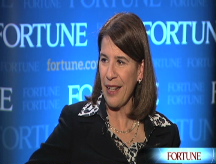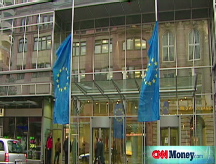Lending shows signs of tightening
Libor rates continue rising as jitters persist. Investors buy up Treasurys on worries about the global economy.
NEW YORK (CNNMoney.com) -- Lending rates continued to rise Friday amid heightened jitters about the credit crunch after Treasury Secretary Henry Paulson said mid-week that the $700 billion bailout would not be used to buy up banks' toxic assets - its original intent.
The 3-month Libor rate edged up for the second-straight day to 2.24% from 2.15%, according to Bloomberg.com. The overnight Libor rate rose for the fourth-straight day to 0.41% from 0.4%.
Paulson said Wednesday that the $700 billion bailout would no longer focus on purchasing toxic assets but instead be used for injecting capital into financial institutions.
"The Treasury's change of plan is helping Libor higher," said Peter Cardillo, chief market economist at Avalon Partners. But Cardillo warned that Libor's recent rise might not be indicative of a trend. Other factors, including the G-20 summit in Washington Friday and Saturday, may have made banks nervous to lend.
"Banks aren't exactly falling out of bed - Libor hasn't skyrocketed," he added. "Libor has come crashing down recently, and anything that comes crashing down needs to stabilize at some point."
Banks jittery: Another analyst echoed the sentiment that Paulson's game-changing announcement may have put banks on edge a bit, but it is still too soon to really know the repercussions on lending rates.
When markets become jittery, "cash remains king," said Kim Rupert, fixed income analyst at Action Economics.
If banks are concerned "that these troubled assets are going to weigh further on their balance sheets and they are concerned about their counter party risk, they would prefer to hold onto reserves." said Rupert.
However, while the change in the bailout program has put banks on edge, "if there was wholesale concern again, you would see rates sky high," she noted.
Another analyst said that the uptick in lending rates was to be expected given the falloff in rates in the past month. "We are clearly not out of the woods, so you should expect volatility even in rates such as Libor," said Kenneth Naehu, managing director and head of fixed income at Bel Air Investment Advisors.
"We have come from more fearful levels to less fearful levels - but there is still an elevated level of concern in the marketplace," said Naehu.
Market gauges: Two market gauges also reflected a tightening of the purse strings.
The Libor-OIS spread rebounded to 1.72 percentage points from 1.62 on Thursday. The spread measures the difference between actual borrowing costs and the expected official borrowing rate from the Fed. It is used as a gauge to determine how much cash is available for lending between banks. The bigger the spread, the less cash is available for lending.
Another indicator, the TED spread, also jumped to 2.10 percentage points from 1.97 points Thursday.
The TED spread measures the difference between the 3-month Libor and the 3-month Treasury bill, and is a key indicator of risk. The higher the spread, the less willing investors are to take risks.
Government bond prices: Treasury prices rose Friday after the European Union reported more bad economic news and U.S. retail sales in October suffered the worst monthly drop on record.
The European economy is officially in a recession, EU officials said Friday. The 15 economies comprising the union have shown two consecutive quarters of negative growth dating back to April. Germany and Italy also individually announced that they have entered a recession.
In the United States, the Commerce Department said Friday that retail sales fell 2.8% last month, compared with a revised 1.3% drop in September. Economists surveyed by Briefing.com on average had forecast a decrease of 2.1% for October.
During times of economic distress, investors tend to seek the safest, though not always the most lucrative, investments possible.
The benchmark 10-year note rose 1-5/32 to 100-9/32, and its yield fell to 3.72% from 3.85% late Thursday. Bond prices and yields move in opposite directions.
The 2-year note was up 1/32 to 100-18/32, and its yield fell to 1.21%.
The benchmark yield curve, the difference between the 2-year and the 10-year yield, narrowed to 2.54 percentage points from a five-year high of 2.62 points set Thursday. The yield curve is a key measure of investor sentiment, with a higher curve indicating a weaker economic environment.
The 30-year bond jumped 2-20/32 to 104-30/32, and its yield fell to 4.21% from 4.36%.
The yield on the 3-month bill fell to 0.12% from 0.18%. The yield on the 3-month Treasury bill is closely watched as an immediate reading on investor confidence, with a lower yield indicating less optimism. Investors and money-market funds shuffle money into and out of the 3-month bill frequently as they assess risk in the rest of the marketplace.
The increased demand for the short-term notes was another indication of market unease. "When you are buying Treasury bonds that are yielding below 1%, you are doing it as a safe haven," said Naehu.
Treasurys fell sharply Thursday after the government auctioned off $10 billion of 10-year notes and $40 billion of 6-month bills. ![]()







